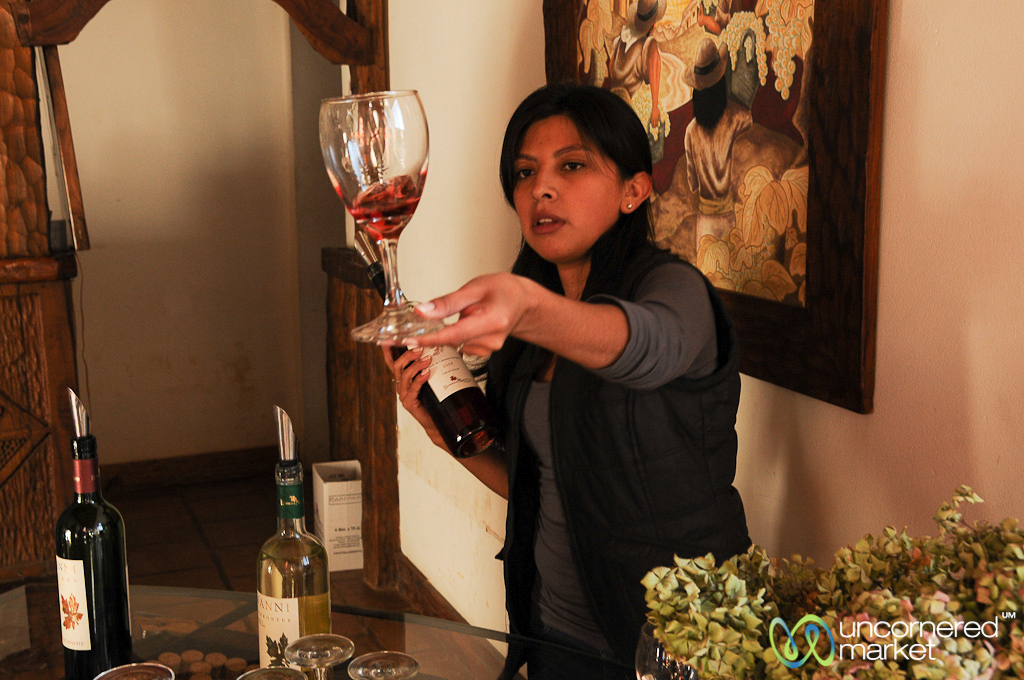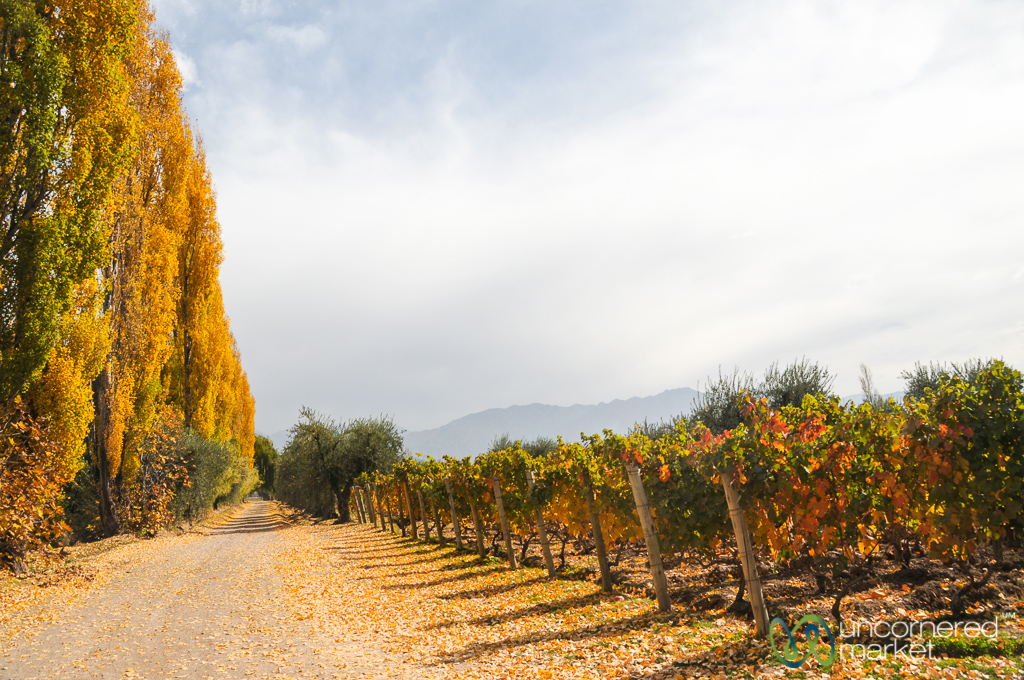On our first evening in Argentina we stumbled into a wine shop in Puerto Iguazu while looking for a bottle to celebrate our arrival in a new country. The store was vast, and it carried only Argentine wines. We were overwhelmed. So many choices, so many varietals, including several we’d never heard of.
Although we considered ourselves wine savvy at the time, we realized — staring at walls of wine, all from the region — that our knowledge of Argentine wines didn’t extend much beyond Mendoza and the varietal for which it is best known, Malbec.
The store’s owner noted our dazed looks, recognized analysis paralysis and asked if we needed help choosing a bottle.
“Where to begin?” was an apt response.

Enjoying a flight of Argentine wine.
Excited for the opportunity to share his passion about wine, he gave us an impromptu lesson, organized by Argentina’s three main wine-growing regions: Mendoza, Cafayate and Patagonia. He focused on the varietals for which each region is most known and also let us in on some secrets, including the little-known blending varietals that we should understand and keep an eye out for in our travels.
Over the next four months we spent travelling through and living in Argentina, we visited each of the country’s main wine regions and engaged in a tasty experiment that involved trying a wide range of varietals and styles.
Here’s what we learned.
Cafayate
One doesn’t usually associate red rocks and desert with growing great wines, but there’s something about the soil in Argentina’s northwest — which is free draining and appropriate for irrigation control and filtering – that makes it work for wineries in Cafayate. Although most vineyards are located on the outskirts of Cafayate, many of them have tasting rooms in town so you can experience the best wines of the region in a walk about town.

Vineyards in the red rocks of Cafayate.

Wine tasting at Bodega Nanni in Cafayate.
Although Cafayate does grow red wine staple varietals like Malbec and Cabernet Sauvignon, it is best known for Torrontes, a must-try white wine varietal. Upon first sniff, the aroma of a typical Torrontes is virtually unmistakable and floral: jasmine, peaches, roses and bits of citrus hints are so aromatic and fresh that you might think you’re about to drink something sweet.
The delivery, however, is understated, featuring mild acidity and a dry finish. Remarkable with spicy empanadas, Torrontes can also pair with sweetbreads and chutney-like sauces or light fish and sweet salsa.
Patagonia
Wine in Patagonia? Yes, indeed. This is Argentina’s newest wine growing area, and it seems to be getting better every year.

Pinot Noir is the name of the game in Patagonian wine region.
While a Patagonian Malbec, Syrah or even Cabernet Sauvignon are worth turning an empty glass to, it’s Pinot Noir for which the northernmost reaches of this province is best known. This varietal is happy for the rocky, well-drained soil and its skins stand up to the windy Patagonian nights, giving it a distinct taste.

A large spread of wines for tasting at Del Fin Del Mundo winery.
Head to the town of Neuquen, the jumping off point for the Patagonian wine route and poke around Rio Negro, an area that feels like the Wild West frontier of viniculture. Wineries like NQN, Familiar Schroeder, Bodega del Fin del Mundo and Bodegas Chacra are all producing Pinot Noirs that have drawn acclaim as word spreads. Depending on the blend of stainless steel and oak barrel aging of your vintage, enjoy with fish, or light meats like lamb and salted pork.
Mendoza
Not only does Mendoza produce some of Argentina’s best wines, but the visible snow-covered Andean peaks, including Acancagua at almost 7,000m (23,000 ft) provide a beautiful, dramatic backdrop. This is Argentina’s largest and oldest wine growing region.

Mendoza vineyards under snow-capped Andean peaks.
Mendoza is comprised of three different sub-regions: Maipu, Lujan de Cuyo and Uco Valley. The last two are at an altitude of 850–1,520m (2,800–5,000 ft) and are considered a cut above, with the most prized and collected wines from Mendoza hailing from Uco Valley.
Maipu is the easiest to get to from the city of Mendoza and features the option to rent bicycles and ride from winery to winery as you taste. The landscape is beautiful with all its vineyards and the cycling experience is excellent, but the actual wine tasting, depending on how discerning your palate, can be hit or miss. The heavily trafficked route can be busy with large groups and mediocre tastings, but pay a little more and you’ll have the opportunity to sample some higher quality wines.

Renting bikes in Maipu valley to ride from winery to winery.
If you are serious about wines, make the effort to visit or taste wines from Lujan de Cuyo or Uco Valley. The wineries there are often smaller, more focused and even feature winemakers from France looking to meld their Old World craft in a New World setting. For some wineries, you may need to call in advance to be sure they are taking visitors that day. You’ll be rewarded for the extra effort with a more personal and quality wine-tasting experience.

Autumn colours in the vineyards of Lujan de Cuyo.
For a range of experiences, try the high volume but approachable Alta Vista winery and sample some of their under-the-bar wines, including with some of the lesser-known varietals below. Then, be sure to treat yourself to the Cabernets made by the charming Carmelo Patti and finish off with a taste of the heady, French-styled wines of Achaval Ferrer.
You’ll most certainly have your fill of Malbec, originally a French varietal, which is the most popular grape grown in this region. But be sure to try Bonarda, now Argentina’s second-most-planted varietal, and Petit Verdot, another substantial Bordeaux-born varietal that you’re sure to taste more of in the coming years.
Today, each time we find a bottle of wine from Argentina in a wine shop in North America or Europe, we remember our Argentine wine explorations. And while we do really enjoy a good Malbec from Mendoza, we get rather excited when we find the more rare Torrentes from Cafayate or a Pinot Noir from Patagonia.
Getting There
G Adventures runs a number of departures in Argentina encompassing a wide range of departure dates and activities to cater for different tastes. We’re thrilled at the prospect of showing you this big blue planet of ours — check out our small group trips here.























